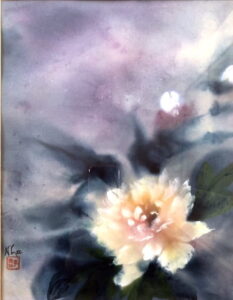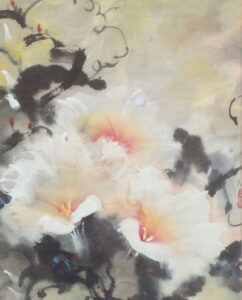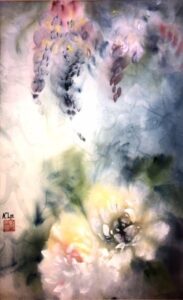Over the years, Clare resident Nancy Lee Spilove made her way through a number of careers before retiring at The Clare in Chicago.
She spent 10 years managing her ex-husband’s medical practice. At age 51, she went to school to become a chef, and later became a culinary arts instructor. For eight years, she worked at a soup kitchen in Florida, followed by a two-year stint teaching at another charity
Despite the career changes, one thing remained constant: Nancy Lee’s love of oriental ornamentation, which led to her passion for Sumi-e, or oriental brush painting.

Mum in Purple
While Nancy Lee’s fascination with oriental furniture and decoration endured throughout her life, her interest in practicing Sumi-e painting sparked about 35 years ago, when she discovered an ad for a Sumi-e instructor – right around the corner from her Florida home, as luck would have it.
It was this instructor who served as a mentor for Nancy Lee, who propelled her into a world where Sumi-e art became far more than a hobby. Nancy Lee grew to enjoy Sumi-e painting so much, in fact, that she completed at least 40 works to date.
“It’s my thing,” she says. “I only wanted to stick with Sumi-e.”
The Sumi-e Process and Special Techniques
The process of starting a Sumi-e painting is quite meditative, according to Nancy Lee. Add a couple of drops of water to an ink stone, and rotate an ink stick to prepare for painting.
“It takes quite a while to get your ink right,” she says. “So it gives me time to cool down and release whatever’s on my mind.”
In addition to this prepared ink, Nancy Lee uses watercolors, rather than grinding her own paints. Typically, she uses various different colors, blending them in the center of a pie plate. She notes the importance of holding the brush straight up and down, too, as opposed to a more natural, instinctive way of placing it in your hand.

Morning Glories and Summer
“It doesn’t sound like much, but when you’re used to doing it another way, to get yourself to do it this way takes some training,” she says.
When learning Sumi-e, artists begin by practicing the Four Gentlemen. They represent the four seasons: an orchid for spring, bamboo for summer, chrysanthemum for autumn, and a plum blossom for winter. The Four Gentlemen allow artists to experiment with their brushstrokes.
“The orchid is a very simple line, but it lets you start controlling the brush and applying pressure differently,” Nancy Lee explains. “This is how you start learning how to paint.”
When a painting is complete, it gets stamped with a chop mark, she says, which is unique for each artist. She has two inscribed chops, for example, one that says Nancy Lee and another that says beautiful young swan.

Wishful
Of the numerous Sumi-e paintings Nancy Lee completed, her favorite is one titled Wishful. She started the painting and did not like its direction, so she tossed it in the wastebasket. When painting another night after supper, she ended up with a lot of paint left over. She recalled the painting in the trash.
“I thought I would use it for something, so I picked up this painting that was in the garbage and it just came together,” Nancy Lee says. “It was almost spiritual.”
At The Clare in Chicago today, it has been about five years since Nancy Lee last finished a piece. But her love for Sumi-e hasn’t faltered. She especially recognizes the value, purpose and peace it has brought to her life.
“My heart just hasn’t been in it, but that may mean this is the time I need it most,” she says. “Maybe if I get back into it, I’d be at ease.”

